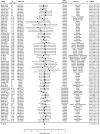Does non-invasive brain stimulation modulate emotional stress reactivity?
- PMID: 31993648
- PMCID: PMC7171378
- DOI: 10.1093/scan/nsaa011
Does non-invasive brain stimulation modulate emotional stress reactivity?
Abstract
Excessive emotional responses to stressful events can detrimentally affect psychological functioning and mental health. Recent studies have provided evidence that non-invasive brain stimulation (NBS) targeting the prefrontal cortex (PFC) can affect the regulation of stress-related emotional responses. However, the reliability and effect sizes have not been systematically analyzed. In the present study, we reviewed and meta-analyzed the effects of repetitive transcranial magnetic (rTMS) and transcranial direct current stimulation (tDCS) over the PFC on acute emotional stress reactivity in healthy individuals. Forty sham-controlled single-session rTMS and tDCS studies were included. Separate random effects models were performed to estimate the mean effect sizes of emotional reactivity. Twelve rTMS studies together showed no evidence that rTMS over the PFC influenced emotional reactivity. Twenty-six anodal tDCS studies yielded a weak beneficial effect on stress-related emotional reactivity (Hedges' g = -0.16, CI95% = [-0.33, 0.00]). These findings suggest that a single session of NBS is insufficient to induce reliable, clinically significant effects but also provide preliminary evidence that specific NBS methods can affect emotional reactivity. This may motivate further research into augmenting the efficacy of NBS protocols on stress-related processes.
Keywords: emotion; repetitive transcranial magnetic stimulation; review; stress; transcranial direct current stimulation.
© The Author(s) 2020. Published by Oxford University Press.
Figures





References
-
- Ahmadizadeh M.-J., Rezaei M. (2018). Unilateral right and bilateral dorsolateral prefrontal cortex transcranial magnetic stimulation in treatment post-traumatic stress disorder: a randomized controlled study. Brain Research Bulletin, 140, 334–40. doi: 10.1016/j.brainresbull.2018.06.001. - DOI - PubMed
Publication types
MeSH terms
LinkOut - more resources
Full Text Sources
Research Materials
Miscellaneous

